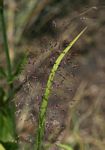| Home | > | List of families | > | Poaceae | > | Capillipedium | > | parviflorum |
Capillipedium parviflorum
Selected images: Click on each image to see a larger version and details of the record View all images (1)
Detailed records: Display species records QDS maps by: Google Maps Point records by Google Maps
Species details: Click on each item to see an explanation of that item (Note: opens a new window)
| Synonyms: |
Anatherum parviflorum (R. Br.) Spreng. Andropogon alternans J. Presl Andropogon capilliflorus Steud. Andropogon micranthus Kunth Andropogon parvispicus Steud. Andropogon quartinianus A. Rich. Andropogon serratus Miq. Andropogon villosulus Nees ex Steud. Andropogon violascens (Trin.) Nees ex Steud. Chrysopogon parviflorus (R. Br.) Benth. Chrysopogon parvispicus (Steud.) W. Watson Chrysopogon violascens Trin. Holcus caerulescens Gaud. Holcus parviflorus R. Br. Rhaphis caerulescens (Gaud.) Desv. Rhaphis microstachya Nees ex Steud. Sorghum parviflorum (R. Br.) P. Beauv. |
| Common names: | |
| Frequency: | |
| Status: | Native |
| Description: |
Caespitose perennial; culms mostly 75–100 cm high with barbate nodes; leaf sheaths tight or eventually slipping from the culms, the lowermost longer than and the remainder shorter than the internodes, ± covered in tubercle-based hairs and frequently villous on the collar; ligule a very short, truncate, ciliolate membrane; leaf laminas up to 30 cm × 2.5 mm, glaucous, erect and straight, linear from an often narrowed and slightly contracted base, flat, scabrid on the margins, finely pointed at the apex. Panicle 8–25 cm long; racemes reduced to 1 sessile and 2 pedicelled spikelets, rarely with 2 sessile and 3 pedicelled spikelets; rhachis internodes glabrous, the pedicels hairy on the margins. Sessile spikelet 2.8–5 mm long, narrowly oblong; inferior glume with short hairs on the back, shallowly concave in the middle, with 2 intercarinal nerves, ciliate on the keels above, truncate at the apex; superior glume 1-keeled, scabrid on the keel, the median nerve excurrent as a short mucro; inferior lemma empty, 2–2.5 mm long, ovate; superior lemma stipitiform, linear, flattened, 1-nerved, entire; awn c. 20 mm long (including the lemma), minutely hispidulous; anthers c. 1.5 mm long. Pedicelled spikelets 2.5–3.5 mm long, lanceolate, male or neuter; inferior glume shortly hairy on the keels, with 3 intercarinal nerves, acute at the apex; superior glume glabrous, with 2 intercarinal nerves; inferior lemma oblong, truncate; anthers c. 1.5 mm long. |
| Type location: |
Australia |
| Notes: | Perennial grass, up to 1 m but usually smaller. Inflorescence a delicate, loose panicle. Spikelets reddish-purple with long hair-like awns. |
| Derivation of specific name: | parviflorum: small flowered |
| Habitat: | Widespread in various types of grassland. |
| Altitude range: (metres) | 40 - 1400 m |
| Flowering time: | |
| Worldwide distribution: | China, Japan, widespread throughout the Old World tropics |
| National distribution: | N,MS |
| Growth form(s): | |
| Endemic status: | |
| Red data list status: | |
| Insects associated with this species: | |
| Spot characters: | Display spot characters for this species |
| Literature: |
Cope, T.A. (2002). Poaceae Flora Zambesiaca 10(4) Pages 42 - 44. (Includes a picture). Jackson, G. & Wiehe, P.O. (1958). An Annotated Check List of Nyasaland Grasses The Government Printer, Zomba, Nyasaland Page 32. Mapaura, A. & Timberlake, J. (eds) (2004). A checklist of Zimbabwean vascular plants Southern African Botanical Diversity Network Report No. 33 Sabonet, Pretoria and Harare Page 101. Setshogo, M.P. (2000). Notes on the grass subtribe Sorghinae (Poaceae: Andropogoneae) in the Flora Zambesiaca area Kirkia 17(2) Pages 141 - 142. |
Other sources of information about Capillipedium parviflorum:
Our websites:
Flora of Malawi: Capillipedium parviflorumFlora of Zambia: Capillipedium parviflorum
Flora of Zimbabwe: Capillipedium parviflorum
External websites:
African Plants: A Photo Guide (Senckenberg): Capillipedium parviflorumAfrican Plant Database: Capillipedium parviflorum
BHL (Biodiversity Heritage Library): Capillipedium parviflorum
EOL (Encyclopedia of Life): Capillipedium parviflorum
GBIF (Global Biodiversity Information Facility): Capillipedium parviflorum
Google: Web - Images - Scholar
iNaturalist: Capillipedium parviflorum
IPNI (International Plant Names Index): Capillipedium parviflorum
JSTOR Plant Science: Capillipedium parviflorum
Mansfeld World Database of Agricultural and Horticultural Crops: Capillipedium parviflorum
Plants of the World Online: Capillipedium parviflorum
Tropicos: Capillipedium parviflorum
Wikipedia: Capillipedium parviflorum
| Home | > | List of families | > | Poaceae | > | Capillipedium | > | parviflorum |
